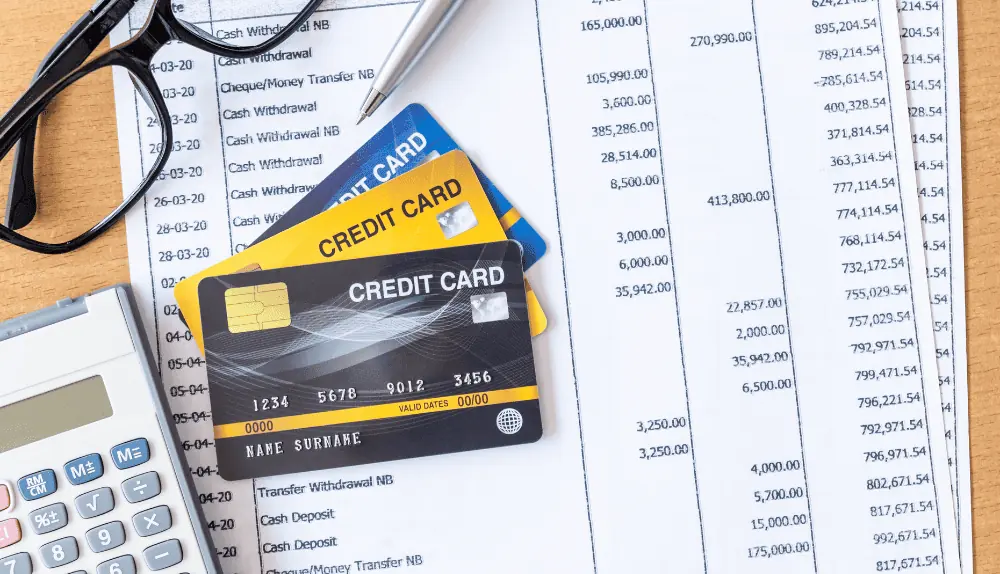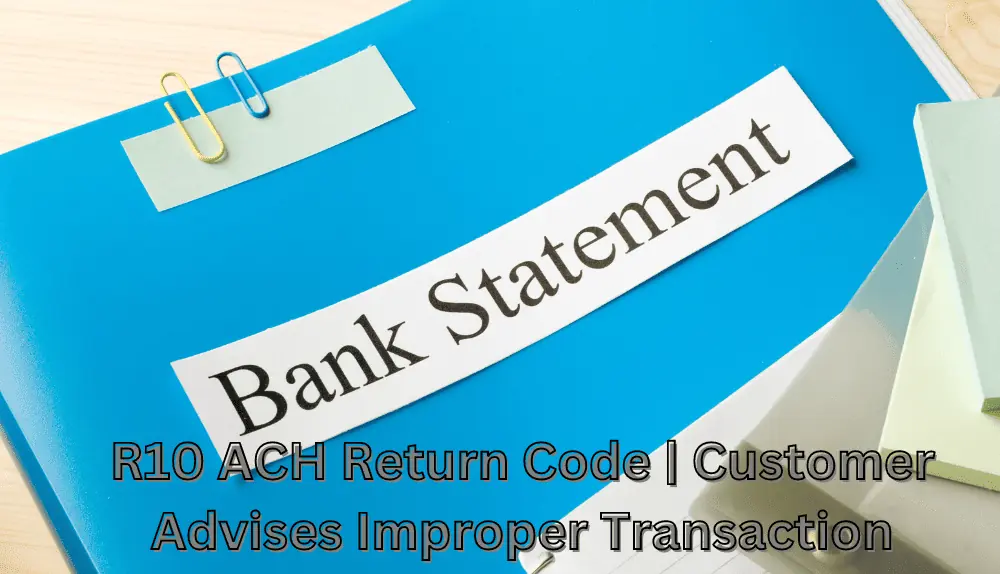In the fast-paced world of digital finance, where transactions occur at the speed of a keystroke, occasional hiccups are inevitable. Imagine eagerly checking your bank statement, only to discover an enigmatic code: “R10 ACH Return Code | Customer Advises Improper Transaction.” Your heart skips a beat, your mind races with questions, and a sense of uncertainty envelops you.
Fear not, for amidst the cryptic jargon lies a tale of financial vigilance, consumer empowerment, and the triumph of knowledge over obscurity. Join us as we unravel the mystery behind the R10 ACH Return Code, demystify its implications, and empower you with the understanding to navigate the world of electronic payments with newfound confidence.
What Does R10 ACH Return Code Mean?
The ACH R10 return code, also known as the “Customer Advises Improper Transaction,” is a standard code used in the Automated Clearing House (ACH) network to indicate that a financial transaction has been rejected and returned to the originating bank. This code typically arises when a customer disputes the validity of a specific ACH debit entry on their account.

When a customer encounters an unfamiliar or unauthorized transaction on their bank statement, they have the right to question its legitimacy. Upon notifying their bank of a potential error or unauthorized transaction, the bank may investigate the matter. If the bank finds evidence supporting the customer’s claim of an improper or unauthorized transaction, they will initiate a return process using the ACH R10 return code.
By employing the ACH R10 return code, financial institutions aim to safeguard customers against fraudulent or mistaken transactions, providing them with a channel to voice their concerns and seek resolution. This mechanism reinforces trust in the ACH network and promotes consumer confidence in electronic payment systems.
As a customer, it is essential to monitor your financial transactions regularly and report any suspicious activities promptly. The ACH R10 return code serves as a crucial tool in maintaining the integrity and security of electronic payments, offering consumers peace of mind and protection in the realm of modern finance.
Reasons R10 ACH Return Code Can Occur
The ACH R10 return code, known as “Customer Advises Improper Transaction,” can occur for various reasons, each stemming from potential discrepancies, errors, or unauthorized activities in the automated clearing house (ACH) transaction process. Understanding these reasons can help consumers and businesses navigate the complexities of the ACH network and address issues promptly.
Unauthorized Transactions
One of the primary reasons for the ACH R10 return code is when a customer identifies an unauthorized transaction on their bank account. This could be a result of identity theft, fraud, or simply a mistaken entry that the customer does not recognize or authorize
Incorrect Amounts
Discrepancies in the transaction amount can lead to the ACH R10 return code. If the amount debited from a customer’s account does not match the expected or agreed-upon value, the customer has the right to dispute the transaction.
Invalid Account Number
A payment initiated with an incorrect or invalid bank account number will trigger the ACH R10 return code. This can occur due to human error or outdated account information.
Closed Accounts
If an ACH transaction is attempted on a closed or inactive bank account, the bank will return the transaction with the ACH R10 code.
Pre-authorization Not Received
In cases where a merchant or service provider fails to obtain proper pre-authorization for recurring ACH debits, the customer may dispute the transaction, leading to an ACH R10 return.
Procedural Errors
Errors during the transaction initiation process, such as incorrect formatting or missing information, can result in the ACH R10 code.
Dual Presentment
Dual presentment happens when a single ACH transaction is submitted for processing twice, leading to a double debit from the customer’s account.
Expired Authorization
For certain types of ACH transactions with limited validity periods, if the transaction occurs after the authorization has expired, the bank will return it with the ACH R10 code.
Consumer Dissatisfaction
In some cases, a customer may dispute a transaction due to dissatisfaction with the product or service received or if the terms of the transaction were not clearly communicated.
Merchant/Business Errors
Errors on the merchant or business’s end, such as billing the wrong customer or billing the customer for the wrong amount, can result in the ACH R10 return code.
In all these scenarios, it is crucial for customers to promptly contact their bank and initiate a dispute resolution process. Banks will investigate the claims, and if the customer’s concerns are valid, they will return the transaction with the ACH R10 code, ensuring that the customer’s rights and interests are protected. Businesses and merchants should also take preventive measures, such as verifying account information, obtaining proper authorizations, and implementing robust transaction monitoring systems, to minimize the occurrence of ACH R10 return codes and maintain a positive relationship with their customers.
Solutions to Fix R10 ACH Return Code
Fixing the ACH R10 return code, also known as “Customer Advises Improper Transaction,” requires prompt action and effective solutions to address the underlying issues. Whether you are a customer, a business, or a financial institution, implementing the following solutions can help prevent the occurrence of ACH R10 return codes and ensure a smoother ACH transaction process:

Strengthen Customer Communication
For businesses and financial institutions, clear and transparent communication with customers is essential. Provide detailed information about any recurring ACH debits and obtain proper authorization before initiating such transactions. Keep customers informed about transaction amounts, dates, and the purpose of the debits to minimize confusion and potential disputes.
Regularly Update Account Information
Customers should regularly review and update their bank account information with their financial institutions. This includes ensuring that the correct account number, routing number, and other essential details are accurate and up-to-date. Outdated or incorrect account information can lead to ACH R10 return codes.
Implement Multi-Factor Authentication
For businesses processing ACH transactions, implementing multi-factor authentication (MFA) can enhance security and reduce the risk of unauthorized transactions. MFA requires customers to provide multiple forms of identification, such as a password and a one-time code sent to their phone, before authorizing a transaction.
Enhance Transaction Monitoring
Financial institutions and businesses should invest in robust transaction monitoring systems. These systems can detect potential discrepancies or irregularities in ACH transactions, helping to identify and prevent fraudulent activities before they result in ACH R10 return codes.
Promptly Investigate Disputes
When a customer raises a concern about an ACH transaction, financial institutions must promptly investigate the issue. Timely resolution of disputes can prevent the escalation of problems and maintain customer satisfaction.
Educate Customers and Staff
Businesses and financial institutions should educate their customers about ACH transactions, including how to identify authorized transactions and report unauthorized ones. Additionally, staff members should be trained to recognize potential issues and follow proper procedures when processing ACH transactions.
Implement Transaction Limits and Controls
Both businesses and customers can benefit from setting transaction limits and controls. Customers can set limits on their accounts to prevent excessive debits, while businesses can implement controls to verify account information before processing transactions.
Double-Check Transaction Details
Before initiating an ACH transaction, businesses should double-check the accuracy of the transaction details, including the recipient’s account information, the transaction amount, and the authorization status. This simple yet crucial step can help avoid errors that lead to ACH R10 return codes.
Monitor ACH Network Updates
Financial institutions and businesses should stay informed about updates and changes to the ACH network’s rules and regulations. Staying current with industry standards can help ensure compliance and reduce the likelihood of ACH R10 return codes caused by outdated practices.
By implementing these solutions, businesses, customers, and financial institutions can work together to minimize the occurrence of ACH R10 return codes, enhance transaction security, and maintain the efficiency and integrity of the ACH network. Collaboration and diligence are key to providing a seamless and secure ACH transaction experience for all parties involved.
How Businesses Can Deal with R10 ACH Return Code?
When a business encounters an ACH R10 return code, it’s essential to handle the situation promptly and professionally to maintain customer trust and prevent further issues. Here’s a step-by-step guide on how businesses can effectively deal with an ACH R10 return code:
Investigate the Return Reason
Upon receiving the ACH R10 return code notification from your financial institution, investigate the specific reason for the return. Determine whether the transaction was unauthorized, contained incorrect information, or if there were any procedural errors on your end.
Communicate with the Customer
Contact the customer involved in the ACH transaction immediately. Communication is crucial to understand the customer’s perspective and gather additional information. Address their concerns, clarify any misunderstandings, and offer reassurance that you are actively working to resolve the issue.
Verify Authorization
Double-check your records to ensure that you have proper authorization for the ACH transaction in question. If it is a recurring payment, ensure you have obtained the customer’s explicit consent for such transactions and have documentation to support it.
Rectify Errors
If the ACH R10 return code occurred due to an error on your part, such as incorrect account information or an inaccurate transaction amount, rectify the mistake immediately. Resubmit the corrected transaction following the proper ACH guidelines.
Refrain from Reinitiating Unauthorized Transactions
If the ACH return was due to unauthorized activity, do not attempt to reinitiate the transaction without the customer’s explicit consent. Repeatedly attempting unauthorized transactions can lead to more severe consequences and damage your business reputation.
Update Customer Information
Promptly update customer account information if the return was caused by outdated or incorrect details. Request the customer to provide their up-to-date banking information to avoid future return codes.
Improve Transaction Monitoring
Enhance your transaction monitoring system to detect potential discrepancies or unauthorized activities. Investing in advanced fraud detection tools can help identify suspicious transactions and prevent future ACH R10 returns.
Offer Customer Support
Provide exceptional customer support throughout the resolution process. Assure the customer that their concerns are being taken seriously and that you are actively working to resolve the issue. Respond to their inquiries promptly and keep them informed of the progress.
Learn from the Experience
Use the incident as an opportunity to learn and improve your ACH transaction processes. Identify any weaknesses or vulnerabilities in your system and take steps to address them, such as implementing additional security measures or updating internal procedures.
Stay Compliant
Ensure your ACH transactions comply with all relevant rules, regulations, and industry standards. Staying up-to-date with the latest ACH guidelines will help you avoid potential pitfalls and reduce the likelihood of ACH R10 return codes.
Dealing with an ACH R10 return code requires a proactive and customer-centric approach. By promptly addressing the issue, communicating effectively with the customer, and taking preventive measures, businesses can minimize the occurrence of ACH return codes and maintain a positive relationship with their customers.
Final Words
In the realm of modern finance, the ACH R10 return code, or “Customer Advises Improper Transaction,” stands as a crucial mechanism that empowers consumers and businesses alike. This code, though enigmatic at first, unveils a tale of vigilance, empowerment, and resilience. By delving into the reasons behind its occurrence and exploring effective solutions, businesses can navigate the complexities of the ACH network with confidence, ensuring secure transactions and maintaining customer trust.
Emphasizing transparent communication, robust transaction monitoring, and continuous improvement, both businesses and financial institutions can harness the power of the ACH system to foster a seamless and trustworthy electronic payment ecosystem. As technology and finance continue to evolve, embracing the lessons learned from ACH R10 return codes paves the way towards a future where financial transactions are not only efficient but also safeguarded, providing customers with the peace of mind they rightfully deserve. Through c
ollaboration, innovation, and a customer-centric approach, the ACH network will remain a steadfast pillar of modern finance, ensuring smooth transactions and fortifying the bond between businesses and their valued customers.
Frequently Asked Questions (FAQs)
Why did I receive an ACH R10 return code on my bank statement?
You received an ACH R10 return code because a transaction on your account was disputed or considered improper. It could be due to unauthorized activity, incorrect information, or other discrepancies.
What should I do if I see an ACH R10 return code on my bank statement?
If you encounter an ACH R10 return code, promptly contact your bank to inquire about the specific transaction. It's essential to verify the details and report any unauthorized or incorrect transactions.
How can businesses prevent ACH R10 return codes?
Businesses can prevent ACH R10 return codes by implementing multi-factor authentication, updating customer information regularly, enhancing transaction monitoring systems, and obtaining proper authorization for recurring transactions.
What happens if a transaction receives an ACH R10 return code?
When a transaction receives an ACH R10 return code, it means the transaction has been reversed, and the funds will be returned to the customer's account. The business may need to rectify any errors or seek customer approval before reattempting the transaction.
Can ACH R10 return codes be disputed by businesses?
No, ACH R10 return codes are typically raised by customers to dispute transactions. Businesses should work with their customers to resolve any issues related to ACH R10 return codes.
Can ACH R10 return codes be prevented entirely?
While it may not be possible to prevent ACH R10 return codes entirely, businesses and financial institutions can significantly reduce their occurrence by following best practices, maintaining open communication with customers, and employing robust security measures.

